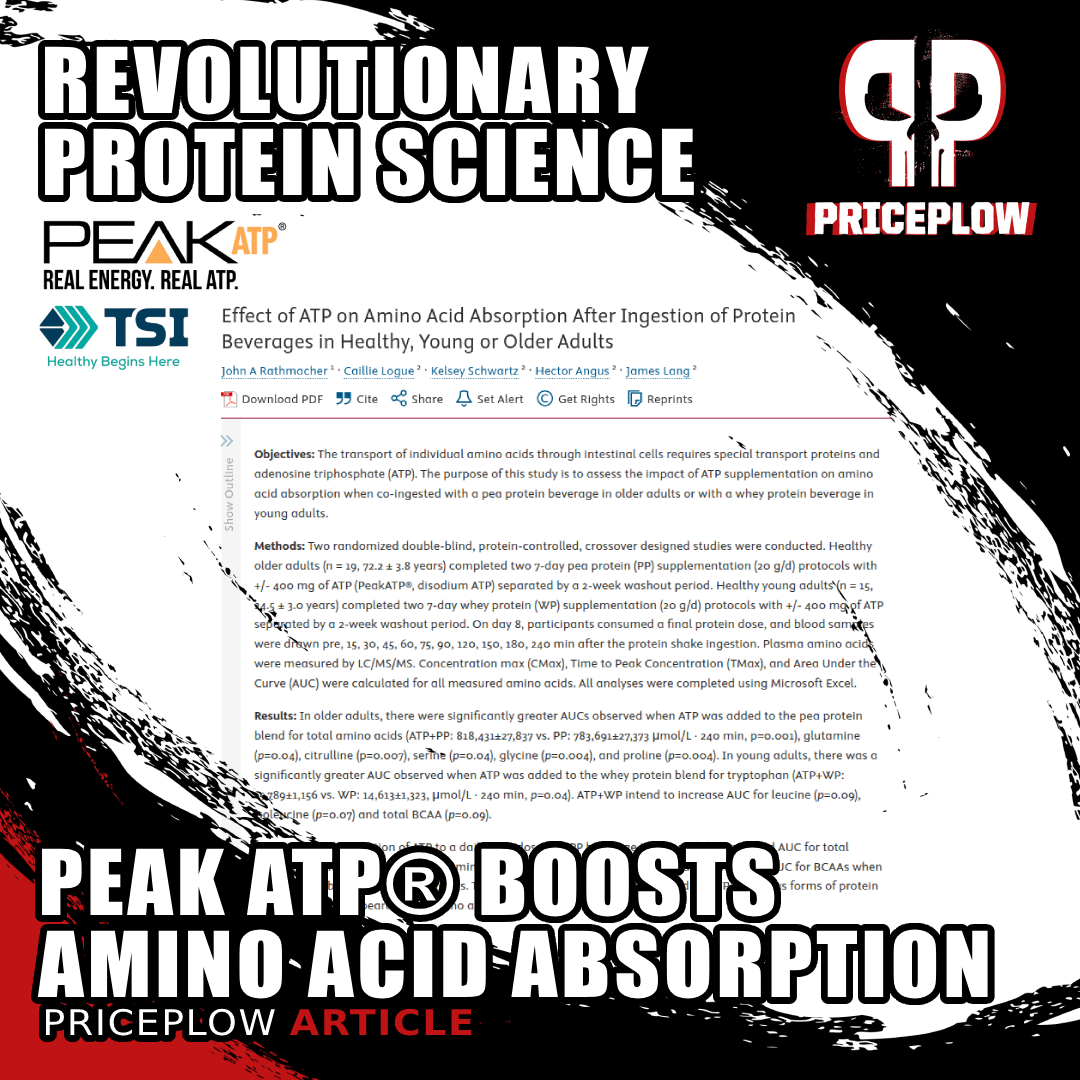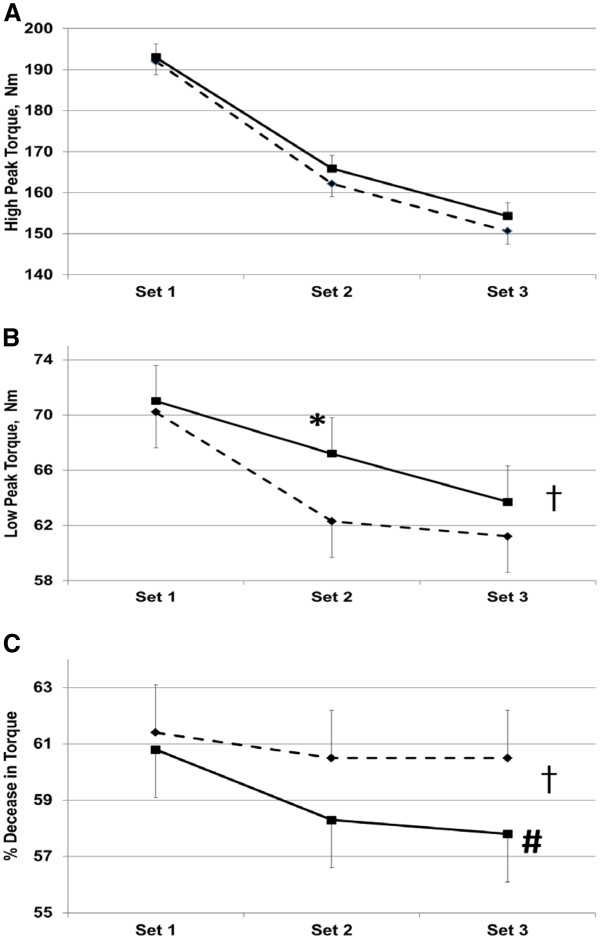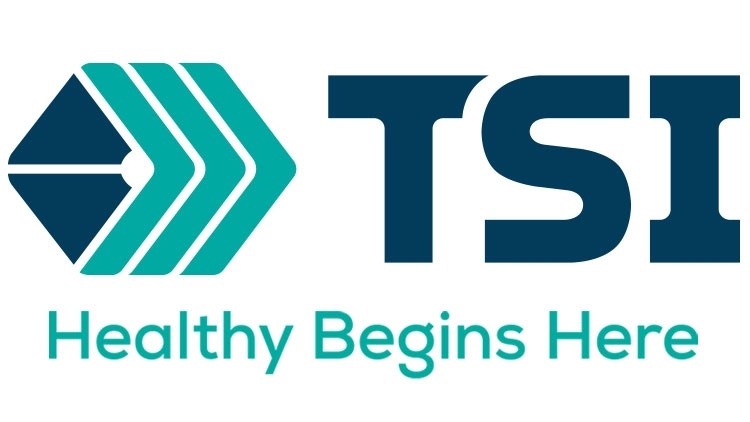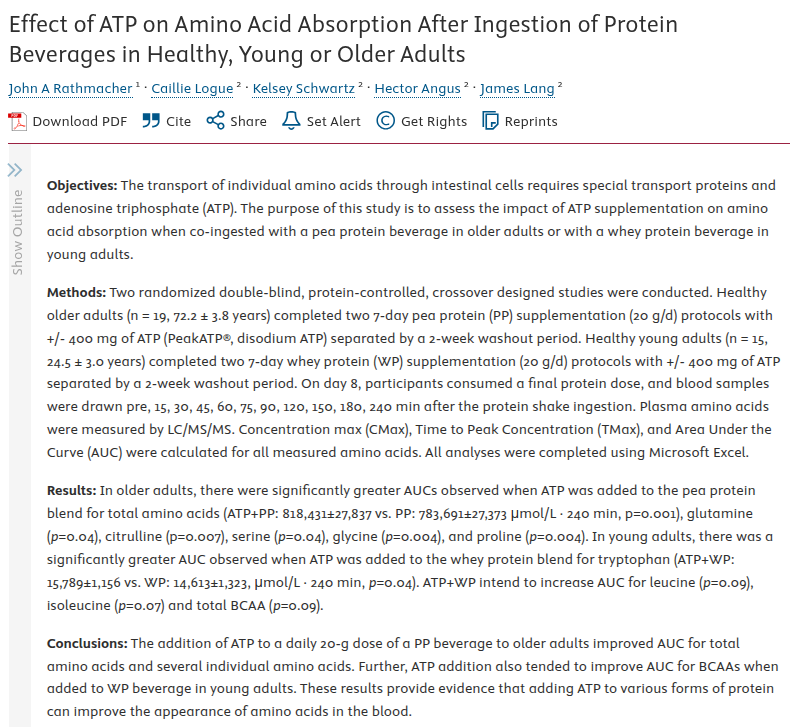New human research shows that PEAK ATP® significantly enhances amino acid uptake from both whey and plant proteins, changing how we think about protein utilization and supplement formulation.

New research reveals PEAK ATP® significantly boosts amino acid absorption from both whey and plant proteins. This addresses a key bottleneck in protein utilization that affects everyone from athletes to aging adults. The 400mg dose enhanced uptake across multiple amino acids in clinical trials.
The supplement industry has spent decades focused on delivering protein to consumers. But what if we've been missing half the equation? New groundbreaking research suggests that the real challenge isn't just getting enough protein in your diet, but ensuring your body can actually absorb and utilize the amino acids from that protein effectively.
PEAK ATP® Enhances Amino Acid Absorption: Revolutionary New Research Changes the Protein Game
PEAK ATP®, TSI Group's clinically-validated form of disodium ATP, has already established itself as a powerful performance enhancer with demonstrated benefits for strength, power output, blood flow, and muscle recovery. But two first-of-their-kind human studies presented at the American Society for Nutrition's "Nutrition 2025" conference bring an entirely new dimension to the novel ingredient's potential -- one that transforms how we can approach protein supplements.[1]
These studies demonstrate that PEAK ATP® significantly enhances amino acid absorption when combined with either plant or animal proteins, addressing a fundamental bottleneck in protein utilization that most people don't even realize exists. The implications extend far beyond just athletes and bodybuilders -- this research opens powerful new applications for healthy aging, clinical recovery, and even malnutrition support.
PEAK ATP® and Protein (or Amino Acids): The Next Level for Protein Intake
The findings are already being put to use in innovative products like Spoken Nutrition's Aminos + ATP, which combines essential amino acids with the clinically-validated 400mg dose of PEAK ATP® used in this research.
Before we dive into the research and specific applications, sign up for our TSI Group and PEAK ATP® notifications so that you don't miss out on new research and product announcements:
Subscribe to PricePlow's Newsletter and Alerts on These Topics
This article will be updated as additional data from these studies becomes available following full publication.
The Study: First-of-its-Kind Research on ATP and Protein Absorption
The research behind these findings consists of two carefully-designed studies that examined PEAK ATP®'s effects on amino acid absorption across different age groups and protein sources.[1]
Both studies utilized the same clinical research design: randomized, double-blind, placebo-controlled crossover trials:
- The first study recruited 19 healthy older adults (average age 72.2 years) who received either 20 grams of pea protein daily with or without 400mg of PEAK ATP® over two separate 7-day protocols, separated by a 2-week washout period.
- The second study followed the same protocol with 15 healthy young adults (average age 24.5 years) using 20 grams of whey protein.
Test Day: Plasma Amino Acids Assayed Measured Post-Protein Ingestion, With and Without ATP Supplementation
The study was designed as follows: On day 8 of each protocol, participants consumed their final protein dose and underwent extensive blood sampling, starting before consumption and then at 15-minute intervals for four hours afterward. Researchers used mass spectrometry analysis to measure plasma amino acid concentrations and calculated key pharmacokinetic parameters including maximum concentration, time to peak, and area under the curve (AUC).
Covering for Potential a Potential Rate-Limiting Bottleneck (ATP for Transport Proteins)
This research matters because amino acid transport through intestinal cells isn't passive -- it requires specialized transport proteins and, critically, ATP as the energy source.[1] By providing supplemental ATP precisely when protein is consumed, PEAK ATP® addresses a potential rate-limiting step in amino acid absorption that could be constraining protein utilization regardless of how much protein someone consumes.
Key Findings: PEAK ATP® Significantly Boosts Amino Acid Uptake
The results from both studies provide incredible evidence that PEAK ATP® enhances amino acid bioavailability in measurable and meaningful ways. While the specific benefits varied between age groups and protein sources, both studies demonstrated clear improvements in amino acid absorption parameters.
-
Older adults and pea protein: Broad improvements
The older adult study revealed the most dramatic and comprehensive benefits. When PEAK ATP® was added to the daily pea protein regimen, researchers observed significantly greater area under the curve (AUC) values for multiple amino acids.[1] AUC is a key measure of total amino acid exposure over time.
The landmark study abstract showing how 400mg of PEAK ATP significantly enhanced amino acid uptake from both pea and whey proteins in older and younger adults, with measurable improvements in total amino acid bioavailability.[1]
Most notably, total amino acids increased significantly from 783,691 μmol/L·240 min with pea protein alone to 818,431 μmol/L·240 min when PEAK ATP® was added.[1] This is a statistically significant improvement that translates to enhanced overall protein utilization.
Significant Individual Amino Acid Improvements (Glutamine, Citrulline, Serine, Glycine, and Proline)
The improvements weren't limited to total amino acids. PEAK ATP® specifically enhanced the absorption of several individual amino acids that play crucial roles in muscle health and metabolic function. Glutamine, the most abundant amino acid in muscle tissue and critical for immune function, showed significantly improved absorption. Citrulline, important for nitric oxide production and blood flow, also demonstrated enhanced uptake. Additionally, the researchers observed significant improvements in serine, glycine, and proline[1] -- amino acids involved in protein synthesis, collagen formation, and metabolic processes.
-
Young adults and whey protein: BCAA trends and tryptophan boost
The young adult study, while showing more targeted effects, revealed important benefits for specific amino acids. Tryptophan absorption increased significantly from 14,613 μmol/L·240 min with whey protein alone to 15,789 μmol/L·240 min when PEAK ATP® was added.[1] This is notable because tryptophan serves as a precursor to serotonin and plays important roles in mood regulation and sleep quality.
There were also strong trends toward improved branched-chain amino acid (BCAA) absorption. While not reaching statistical significance, PEAK ATP® showed great tendencies to enhance leucine and isoleucine uptake, with total BCAA absorption trending higher (p=0.09).[1]
This may have important implications for muscle protein synthesis. Leucine serves as the primary trigger for activating the mTOR pathway, which initiates muscle protein synthesis. Enhanced leucine availability could translate to more robust anabolic signaling, supporting both muscle growth and recovery processes. The fact that these trends appeared even in young, healthy adults suggests that amino acid absorption may be a rate-limiting factor in protein utilization across age groups.
The Mechanism: Why ATP Makes Protein Work Better
Understanding why PEAK ATP® enhances amino acid absorption requires a look at the fundamental biology of protein digestion and transport. The process isn't as simple as amino acids passively diffusing into your bloodstream; it's an active, energy-dependent process that requires cellular machinery and energy.
ATP is essential for maintaining the electrochemical gradients that enable certain amino acid transporters to function.[2] After protein digestion breaks down dietary proteins into individual amino acids, these molecules must cross the intestinal barrier to enter circulation. This transport relies on specialized carrier proteins embedded in the intestinal cell membranes, and crucially, these transporters require ATP to function effectively.
-
Energy for the Amino Acid “Conveyor Belt”
Think of it like a cellular conveyor belt system: the amino acid transporters are the machinery, but ATP is the electricity that powers the entire operation. When ATP levels are insufficient, this transport system becomes the rate-limiting step in amino acid absorption, regardless of how much protein you've consumed.
Peak ATP is a patented oral ATP supplement that's been shown to increase blood flow, boost muscle activation through calcium release, and help boost muscle mass, strength, and recovery. This article covers the biochemistry, mechanism, and human research in detail.
Disodium ATP as PEAK ATP® addresses this bioavailability bottleneck by providing readily available ATP precisely when amino acids are present for absorption. Rather than relying solely on the intestinal cells' endogenous ATP production, which may be limited during the metabolically-demanding process of protein digestion (or by poor metabolic health in general), supplemental PEAK ATP® ensures the transport machinery has adequate energy to operate at peak efficiency.
This mechanism explains why the benefits were observed across different protein sources and age groups -- the fundamental energy requirements for amino acid transport remain consistent, making PEAK ATP® a universal enhancer of protein utilization rather than a protein-specific effect.
-
Bonus: The Neurotransmitter Connection
In addition to enhancing tryptophan absorption -- a serotonin precursor -- ATP itself acts as a neurotransmitter and neuromodulator in both the central and peripheral nervous systems.[3-7] Through purinergic receptors, it influences neuronal signaling and can modulate the release of key neurotransmitters including serotonin, further contributing to its potential mood-related benefits.
Applications Across Multiple Populations
The amino acid absorption benefits of PEAK ATP® translate into practical applications across diverse user groups, each with unique protein utilization challenges.
-
Athletes and performance
Exercise can create a feeling of mental fatigue by eliciting deficits in attention and processing speed. A study published in 2023 showed that PEAK ATP® helps mitigate deficits in several cognitive tasks following exercise.
We already know that PEAK ATP® is great for performance[8-13] as well as post-workout cognitive function.[13] But looking beyond athletic performance, enhanced post-workout amino acid availability brings a significant advantage during the critical recovery window when muscle protein synthesis rates are elevated. Improved BCAA absorption could translate to more robust anabolic signaling, supporting both muscle growth and repair processes.[1]
This enhanced amino acid delivery may enable faster recovery between training sessions and more efficient protein utilization from post-workout meals and supplements, allowing athletes to maximize the benefits of their nutritional investments.
-
Healthy aging and anabolic resistance
The broad amino acid improvements observed in older adults may directly address anabolic resistance -- the age-related decline in muscle protein synthesis response to dietary protein. As we age, our ability to effectively utilize dietary protein diminishes, contributing to muscle loss and metabolic dysfunction.
PEAK ATP®'s enhancement of total amino acid absorption in older adults suggests it could help overcome this resistance, supporting muscle health and metabolic efficiency even when consuming high-quality protein sources like the pea protein used in the study.
-
Recovery and clinical populations
Supplementation with Peak ATP significantly increased the body's vasodilation in response to exercise. The Peak ATP group had 50% greater blood flow than the control group.[14]
In clinical settings where nutrient absorption is often compromised, PEAK ATP®'s ability to enhance amino acid bioavailability could be quite valuable for supporting tissue repair and recovery. The improved delivery of key amino acids like glutamine and glycine may benefit wound healing, immune function, and overall nutritional status.
For populations dealing with malnutrition or absorption issues, maximizing the efficiency of protein utilization becomes critical, making PEAK ATP® a potentially valuable tool in clinical nutrition protocols.
While we're mostly bullish on PEAK ATP® in pre-workout applications, and have used it in hydration formulas, we're excited to see it apply to post-workout and general protein formulas as well!
PEAK ATP® Recap: The Science-Backed Difference
While these new amino acid absorption findings represent an exciting advancement, they build upon PEAK ATP's already impressive foundation of clinical research. TSI Group's patented disodium ATP has accumulated over a decade of human performance studies, establishing it as one of the most thoroughly researched ATP supplements available.[8]
The cornerstone study demonstrated that 400mg of PEAK ATP® daily for 12 weeks significantly increased total body strength by 55 kg compared to just 22 kg in the placebo group[15] -- a massive difference in resistance-trained men who typically see minimal improvements from supplementation. The same study showed substantial improvements in vertical jump power and muscle thickness, with PEAK ATP® users gaining nearly twice the lean mass of controls.

Study subjects who received 400 mg ATP disodium for 2 weeks did significantly better on 3 sets of 50 leg extensions than the placebo group.[10] "Low peak torque" is the lowest peak torque that each group was able to create, on average, during the final 10 reps of each 50 rep set.[10]
PEAK ATP®'s mechanisms also extend well beyond simple energy provision. Research reveals that it functions primarily as a blood flow enhancer, triggering vasodilation and nitric oxide production through purinergic signaling pathways.[16] This blood flow enhancement can increase nutrient and oxygen delivery while improving waste product removal, both of which are effects that complement the amino acid absorption benefits revealed in the latest research.
Additional studies have demonstrated PEAK ATP®'s ability to reduce muscle fatigue during repeated high-intensity exercise, maintain power output in later training sets, and even support cognitive performance during intense physical stress.[17] A comprehensive 2021 review concluded that doses of at least 400mg provide consistent benefits for reducing fatigue, increasing strength and power, improving body composition, and supporting recovery.[8]
As Dr. Ralf Jaeger explained in our detailed podcast discussion, PEAK ATP®'s unique disodium formulation ensures stability, and the research at this point is quite thorough. The consistent 400mg dosing across studies (the same amount used in the new amino acid research) provides formulators and consumers with clear, evidence-based dosing guidelines.
This growing body of research positions PEAK ATP® as more than just a performance ingredient: it's becoming a fundamental enhancer of nutrient utilization and metabolic efficiency across multiple biological systems.
Conclusion: Opening a New Chapter in Protein Science
The groundbreaking research presented at Nutrition 2025 provides a solid advancement in our understanding of protein utilization. By demonstrating that PEAK ATP® significantly enhances amino acid absorption from both plant and animal proteins across different age groups, these studies reveal a previously underappreciated bottleneck in protein metabolism that can affect everyone from elite athletes to aging adults.

Spoken Aminos + ATP brings pro sports expertise to intra-workout nutrition. Clinical-dose Peak ATP meets complete EAAs in an NSF Certified formula backed by NHL champions and LSU's top nutritionist.
This research suggests that the decades-long focus on delivering more protein may have overlooked the equally important challenge of ensuring our bodies can effectively absorb and utilize that protein. PEAK ATP®'s ability to enhance this fundamental biological process opens new possibilities for addressing anabolic resistance in older adults, optimizing recovery in athletes, and supporting clinical populations where nutrient absorption is compromised.
Even better, products like Spoken Nutrition's Aminos + ATP are already in a position to take advantage of the research, since it combines essential amino acids with PEAK ATP®. Now we know they may work together to maximize both delivery and absorption.
As protein science continues evolving, we expect to see more research exploring the intersection of ATP and nutrient utilization. The fundamental biological requirement for ATP in amino acid transport suggests this is just the beginning of understanding how we can optimize protein metabolism at the cellular level.
For those interested in diving deeper into PEAK ATP's complete research profile, our comprehensive PEAK ATP® ingredient guide covers the full spectrum of performance and health benefits this innovative ingredient provides.
Stay updated on the latest PEAK ATP® research and product developments by signing up for our news alerts:








Comments and Discussion (Powered by the PricePlow Forum)